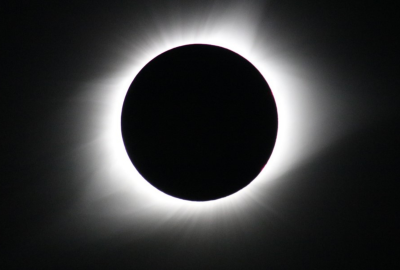The upcoming total solar eclipse on April 8 is expected to be a rare event thanks to the sun being more active, a solar physicist told Newsweek.
The celestial phenomenon in April, which will pass over a vast majority of the United States, Mexico and Canada, coincides with the peak of a solar maximum when the sun is exceptionally active, according to forecasters with NASA and the US National Center for Atmospheric Research (NCAR).
The sun’s activity ebbs and flows during 11-year cycles and the peak of solar maximum is approaching this year, Space Weather Prediction Center Bryan Brasher previously told Newsweek. During a solar maximum, the sun more frequently spews coronal mass ejections (CME), which are massive eruptions of magnetized plasma from the sun’s outer atmosphere, called the corona, Brasher said. These CMEs cause a spike in geomagnetic storms and solar flares as well as “generate spectacular auroras,” he said.
Scott McIntosh, a solar physicist with NCAR, told Newsweek in an interview on Sunday night that the solar eclipse in April will be an “incredible” event because of all that activity.
NCAR

NASA/Gopalswamy
What makes this solar eclipse unique
While there are roughly two solar eclipses visible somewhere on Earth per year, totality happens less frequently, according to NASA. A total solar eclipse occurs when the moon passes between the sun and Earth and completely blocks the view of the sun, leading to momentary darkness.
The April eclipse will be the last total solar eclipse visible in the U.S. until 2044, according to NASA.
This year’s event is expected to look different from more recent solar eclipses due to the solar maximum. In 2017, the last total solar eclipse, the round “orb” appeared smoother because it occurred near a solar minimum, McIntosh said.
The solar physicist said the April eclipse’s appearance will resemble more of an “angry hedgehog.”
“You can see the solar maximum eclipse corona is very spiky and the influence for my ‘angry hedgehog’ comment,” he said.
“In addition to the highly structured corona at maximum, there is also a lot more dynamics driving those magnetic fields on the sun’s ‘surface’ so the potential for observing a solar flare or ‘coronal mass ejection’ is way higher at a maximum total eclipse,” McIntosh added.
The path
More than 31 million people live in the path of totality for April’s total solar eclipse, according to NASA, which states celestial event will pass over Mexico, the United States and Canada.
The total solar eclipse will begin over the South Pacific Ocean, and weather permitting, the first area in continental North America that will experience totality is Mexico’s Pacific coast at around 11:07 a.m. PDT, according to NASA.
The path is expected to then continue from Mexico into the U.S., where it’ll span across Texas, Oklahoma, Arkansas, Missouri, Illinois, Kentucky, Indiana, Ohio, Pennsylvania, New York, Vermont, New Hampshire and Maine, NASA states, noting that small parts of Tennessee and Michigan will also experience a total solar eclipse. The eclipse will also continue through parts of Canada.
People in states that are included in the path of totality can also expect to see a partial eclipse before and after the period of totality. The timeframe for when the total solar eclipse will occur varies by location, but spectators can likely view the celestial event for more than an hour with the totality taking several minutes.
In Dallas, Texas, Dallas, a partial solar eclipse is estimated to begin at 12:23 p.m. CDT and end at 3:02 p.m., with the totality beginning about 1:40 p.m. and lasting until roughly 1:44 p.m., according to NASA. For eclipse revelers in Caribou, Maine, the partial eclipse is estimated to start at 2:22 p.m. EST and end around 4:40 p.m., with the totality beginning at 3:32 p.m. and lasting about two minutes.
While 13 states will be in the path, NASA says almost at least a partial eclipse will be viewable in the U.S.
“You don’t need to live within the path of totality to see the eclipse – in April, 99 percent of people who reside in the United States will be able to see the partial or total eclipse from where they live,” NASA states on its website. “Every contiguous U.S. state, plus parts of Alaska and Hawaii, will experience at least a partial solar eclipse.”
What to expect
For spectators along the path of totality, it might get chilly for a few minutes, McIntosh told Newsweek.
“If you are on the path of totality you’ll experience an appreciable change in temperature, and noise as the birds and insects get fooled by the fake twilight,” he said, noting that in Wyoming during the 2017 total solar eclipse, there was a drop of about 10 degrees during totality.
McIntosh said that while he advises wearing eye protection “up to and after totality,” he said taking the glasses off during totality can help get a better view of the iconic glowing “orb” or “halo.”
“During totality, you have to remove the light blockers,” McIntosh said. “Remember, the corona you’re looking at is one million times fainter than the disk of the sun you are blocking out.”
“It’s a full experience, audio and visual,” he said. “The reaction of the local wildlife is something else – as is that of those around you also taking in the ‘feast.’ The ghostly colors of the totality eclipse are very hard to capture and best experienced without the glasses. The shimmering light of the eclipse corona is incredible, and many become ‘addicted’ to the experience.”
Uncommon Knowledge
Newsweek is committed to challenging conventional wisdom and finding connections in the search for common ground.
Newsweek is committed to challenging conventional wisdom and finding connections in the search for common ground.


